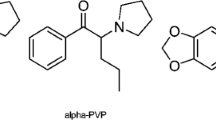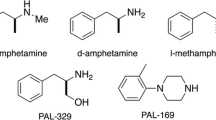Abstract
Rationale
Synthetic cathinones have emerged as the newest class of abused monoamine transporter substrates. Structurally, these compounds are all beta-ketone amphetamine (cathinone) analogs. Whether synthetic cathinone analogs produce differential behavioral effects from their amphetamine analog counterparts has not been systematically examined. Preclinical drug discrimination procedures have been useful for determining the structure activity relationships (SARs) of abused drugs; however, direct comparisons between amphetamine and cathinone analogs are lacking and, in particular, in non-human primate models.
Objectives
The study aim was to determine the potency and time course of (±)-amphetamine, (±)-cathinone, and (±)-methamphetamine and their 3,4-methylenedioxy analogs (±)-MDA, (±)-MDC, and (±)-MDMA, respectively, to produce cocaine-like discriminative stimulus effects. If cathinone analogs have similar behavioral pharmacological properties to their amphetamine counterparts, then we would predict similar potencies and efficacies to produce cocaine-like discriminative stimulus effects.
Methods
Male rhesus monkeys (n = 4) were trained to discriminate intramuscular cocaine (0.32 mg/kg) from saline in a two-key food-reinforced discrimination procedure.
Results
Racemic amphetamine, cathinone, and methamphetamine produced dose-dependent and full substitution, ≥90 % cocaine-appropriate responding, in all monkeys. Addition of 3,4-methylenedioxy moiety attenuated both the potency and efficacy of amphetamine (MDA), cathinone (MDC), and methamphetamine (MDMA) to produce full cocaine-like effects. Moreover, the cocaine-like effects of amphetamine and cathinone were attenuated to a greater extent than those of methamphetamine or previously published methcathinone (Smith et al. 2016).
Conclusion
The presence of an N-methyl group blunted both the potency and the efficacy shift of the 3,4-methylenedioxy addition for both amphetamine and cathinone analogs.




Similar content being viewed by others
References
Banks ML (2014) Effects of the nicotinic acetylcholine receptor antagonist mecamylamine on the discriminative stimulus effects of cocaine in male rhesus monkeys. Exp Clin Psychopharmacol 22:266–273
Banks ML, Blough BE, Fennell TR, Snyder RW, Negus SS (2013) Role of phenmetrazine as an active metabolite of phendimetrazine: evidence from studies of drug discrimination and pharmacokinetics in rhesus monkeys. Drug Alcohol Depend 130:158–166
Banks ML, Bauer CT, Blough BE, Rothman RB, Partilla JS, Baumann MH, Negus SS (2014) Abuse-related effects of dual dopamine/serotonin releasers with varying potency to release norepinephrine in male rats and rhesus monkeys. Exp Clin Psychopharmacol 22:274–284
Banks ML, Hutsell BA, Blough BE, Poklis JL, Negus SS (2015) Preclinical assessment of lisdexamfetamine as an agonist medication candidate for cocaine addiction: Effects in rhesus monkeys trained to discriminate cocaine or to self-administer cocaine in a cocaine versus food choice procedure. Int J Neuropsychopharmacol 18:pyv009. doi:10.1093/ijnp/pyv009
Banks ML, Smith DA, Kisor DF, Poklis JL (2016) Relationship between discriminative stimulus effects and plasma methamphetamine and amphetamine levels of intramuscular methamphetamine in male rhesus monkeys. Pharmacol Biochem Behav 141:58–65
Baumann MH, Clark RD, Woolverton WL, Wee S, Blough BE, Rothman RB (2011) In vivo effects of amphetamine analogs reveal evidence for serotonergic inhibition of mesolimbic dopamine transmission in the rat. J Pharmacol Exp Ther 337:218–225
Baumann MH, Ayestas MA, Partilla JS, Sink JR, Shulgin AT, Daley PF, Brandt SD, Rothman RB, Ruoho AE, Cozzi NV (2012) The designer methcathinone analogs, mephedrone and methylone, are substrates for monoamine transporters in brain tissue. Neuropsychopharmacology 37:1192–1203
Bonano JS, Banks ML, Kolanos R, Sakloth F, Barnier ML, Glennon RA, Cozzi NV, Partilla JS, Baumann MH, Negus SS (2015) Quantitative structure–activity relationship analysis of the pharmacology of para-substituted methcathinone analogues. Br J Pharmacol 172:2433–2444
Council National Research (2011) Guide for the care and use of laboratory animals, 8th edn. National Academies Press, Washington DC
Cozzi NV, Brandt SD, Daley PF, Partilla JS, Rothman RB, Tulzer A, Sitte HH, Baumann MH (2013) Pharmacological examination of trifluoromethyl ring-substituted methcathinone analogs. Eur J Pharmacol 699:180–187
Dal Cason TA, Young R, Glennon RA (1997) Cathinone: an investigation of several N-alkyl and methylenedioxy-substituted analogs. Pharmacol Biochem Behav 58:1109–1116
U.S. Drug Enforcement Administration, Office of Diversion Control (2014). National Forensic Laboratory Information System special report: synthetic cannabinoids and synthetic cathinones reported in NFLIS, 2010–2013. Springfield, VA: U.S. Drug Enforcement Administration. https://www.nflis.deadiversion.usdoj.gov/DesktopModules/ReportDownloads/Reports/NFLIS_SR_CathCan_508.pdf
Evans SM, Johanson CE (1986) Discriminative stimulus properties of (+/-)-3,4-methylenedioxymethamphetamine and (+/-)-3,4-methylenedioxyamphetamine in pigeons. Drug Alcohol Depend 18:159–164
Garza RD, Johanson CE (1983) The discriminative stimulus properties of cocaine in the rhesus monkey. Pharmacol Biochem Behav 19:145–148
Gatch MB, Taylor CM, Forster MJ (2013) Locomotor stimulant and discriminative stimulus effects of ‘bath salt’ cathinones. Behav Pharmacol 24:437–447
Gatch MB, Rutledge MA, Forster MJ (2015) Discriminative and locomotor effects of five synthetic cathinones in rats and mice. Psychopharmacology 232:1197–1205
Glennon RA (1986) Discriminative stimulus properties of phenylisopropylamine derivatives. Drug Alcohol Depend 17:119–134
Glennon RA, Young R (1984a) MDA: a psychoactive agent with dual stimulus effects. Life Sci 34: 379-83.
Glennon RA, Young R (1984b) MDA: an agent that produces stimulus effects similar to those of 3,4-DMA, LSD and cocaine. Eur J Pharmacol 99: 249-50.
Glennon RA, Young R (2011) Drug discrimination and in vivo structure-activity relationships. In: Glennon RA, Young R (eds) Drug discrimination: applications to medicinal chemistry and drug studies. Wiley, Hoboken, pp 163–181
Glennon RA, Young R, Hauck AE, McKenney JD (1984) Structure-activity studies on amphetamine analogs using drug discrimination methodology. Pharmacol Biochem Behav 21:895–901
Glennon RA, Yousif M, Naiman N, Kalix P (1987) Methcathinone: a new and potent amphetamine-like agent. Pharmacol Biochem Behav 26:547–551
Huang D, Wilson MC (1986) Comparative discriminative stimulus properties of dl-rmcathinone, d-amphetamine, and cocaine in rats. Pharmacol Biochem Behav 24:205–210
Kamien JB, Woolverton WL (1989) A pharmacological analysis of the discriminative stimulus properties of d-amphetamine in rhesus monkeys. J Pharmacol Exp Ther 248:938–946
Kamien JB, Johanson CE, Schuster CR, Woolverton WL (1986) The effects of (±)-methylenedioxymethamphetamine and (±)-methylenedioxyamphetamine in monkeys trained to discriminate (+)-amphetamine from saline. Drug Alcohol Depend 18:139–147
KankaanpÄÄ A, Meririnne E, Lillsunde P, SeppÄlÄ T (1998) The acute effects of amphetamine derivatives on extracellular serotonin and dopamine levels in rat nucleus accumbens. Pharmacol Biochem Behav 59:1003–1009
Khorana N, Pullagurla MR, Young R, Glennon RA (2004) Comparison of the discriminative stimulus effects of 3,4-methylenedioxymethamphetamine (MDMA) and cocaine: asymmetric generalization. Drug Alcohol Depend 74:281–287
Kleven MS, Anthony EW, Woolverton WL (1990) Pharmacological characterization of the discriminative stimulus effects of cocaine in rhesus monkeys. J Pharmacol Exp Ther 254:312–317
Kueh D, Baker LE (2007) Reinforcement schedule effects in rats trained to discriminate 3,4-methylenedioxymethamphetamine (MDMA) or cocaine. Psychopharmacology 189:447–457
Lamas X, Negus SS, Hall E, Mello NK (1995) Relationship between the discriminative stimulus effects and plasma concentrations of intramuscular cocaine in rhesus monkeys. Psychopharmacology 121:331–338
Lamb RJ, Henningfield JE (1994) Human d-amphetamine drug discrimination: methamphetamine and hydromorphone. J Exp Anal Behav 61:169–180
Nash JF, Nichols DE (1991) Microdialysis studies on 3,4-methylenedioxyamphetamine and structurally related analogues. Eur J Pharmacol 200:53–58
Negus SS, Mello NK, Blough BE, Baumann MH, Rothman RB (2007) Monoamine releasers with varying selectivity for dopamine/norepinephrine versus serotonin release as candidate “agonist” medications for cocaine dependence: Studies in assays of cocaine discrimination and cocaine self-administration in rhesus monkeys. J Pharmacol Exp Ther 320:627–636
Pehek EA, Schechter MD, Yamamoto BK (1990) Effects of cathinone and amphetamine on the neurochemistry of dopamine in vivo. Neuropharmacology 29:1171–1176
Rothman RB, Baumann MH, Dersch CM, Romero DV, Rice KC, Carroll FI, Partilla JS (2001) Amphetamine-type central nervous system stimulants release norepinephrine more potently than they release dopamine and serotonin. Synapse 39:32–41
Rothman RB, Vu N, Partilla JS, Roth BL, Hufeisen SJ, Compton-Toth BA, Birkes J, Young R, Glennon RA (2003) In vitro characterization of ephedrine-related stereoisomers at biogenic amine transporters and the receptorome reveals selective actions as norepinephrine transporter substrates. J Pharmacol Exp Ther 307:138–145
Sakloth F, Kolanos R, Mosier PD, Bonano JS, Banks ML, Partilla JS, Baumann MH, Negus SS, Glennon RA (2015) Steric parameters, molecular modeling and hydropathic interaction analysis of the pharmacology of para-substituted methcathinone analogues. Br J Pharmacol 172:2210–2218
Sevak RJ, Stoops WW, Hays LR, Rush CR (2009) Discriminative stimulus and subject-rated effects of methamphetamine, d-amphetamine, methylphenidate, and triazolam in methamphetamine-trained humans. J Pharmacol Exp Ther 328:1007–1018
Simmler LD, Buser TA, Donzelli M, Schramm Y, Dieu LH, Huwyler J, Chaboz S, Hoener MC, Liechti ME (2013) Pharmacological characterization of designer cathinones in vitro. Br J Pharmacol 168:458–470
Smith DA, Negus SS, Poklis JL, Blough BE, Banks ML (2016) Cocaine-like discriminative stimulus effects of alpha-pyrrolidinovalerophenone, methcathinone and their 3,4-methylenedioxy or 4-methyl analogs in rhesus monkeys. Addict Biol. doi: 10.1111/adb.12399.
Spealman RD (1995) Noradrenergic involvement in the discriminative stimulus effects of cocaine in squirrel monkeys. J Pharmacol Exp Ther 275:53–62
Suyama JA, Sakloth F, Kolanos R, Glennon RA, Lazenka MF, Negus SS, Banks ML (2016) Abuse-related neurochemical effects of para-substituted methcathinone analogs in rats: microdialysis studies of nucleus accumbens dopamine and serotonin. J Pharmacol Exp Ther 356:182–190
Woolverton WL, English JA (1997) Effects of some phenylethylamines in rhesus monkeys trained to discriminate (+)-amphetamine from saline. Drug Alcohol Depend 44:79–85
Young R, Glennon RA (1993) Cocaine-stimulus generalization to two new designer drugs: methcathinone and 4-methylaminorex. Pharmacol Biochem Behav 45:229–231
Acknowledgments
We acknowledge Crystal Reyns for the technical assistance, Kevin Costa for coding the original behavioral program version, and David E. Nichols for the generous (±)-MDMA HCl donation.
Authorship contributions
Participated in research design: Banks
Conducted experiments: Smith
Contributed new reagents: Blough
Recorded data analysis: Banks
Wrote or contributed to the writing of the manuscript: Smith, Blough, and Banks
Author information
Authors and Affiliations
Corresponding author
Ethics declarations
The experiments were conducted in accordance with the eighth edition of Guide for the Care and Use of Laboratory Animals (2011) and under Institutional Animal Care and Use Committee-approved research and enrichment protocols.
Funding
Research reported in this publication was supported by the National Institute on Drug Abuse of the National Institutes of Health under award number R01DA031718 and R01DA012970 and institutional professional development funds. The content is solely the responsibility of the authors and does not necessarily represent the official views of the National Institutes of Health.
Conflict of interest
Mr. Smith declares no conflicts of interest. Dr. Blough declares NIH has funded his research. Dr. Banks declares NIH has funded his research. During the past 3 years, he has received compensation as a collaborator with Purdue pharmaceutical for projects related to opioid pharmacology and drug development. Dr. Banks declares that the present study was not related to this professional relationship and should not be perceived as constituting a conflict of interest.
Rights and permissions
About this article
Cite this article
Smith, D.A., Blough, B.E. & Banks, M.L. Cocaine-like discriminative stimulus effects of amphetamine, cathinone, methamphetamine, and their 3,4-methylenedioxy analogs in male rhesus monkeys. Psychopharmacology 234, 117–127 (2017). https://doi.org/10.1007/s00213-016-4444-1
Received:
Accepted:
Published:
Issue Date:
DOI: https://doi.org/10.1007/s00213-016-4444-1




